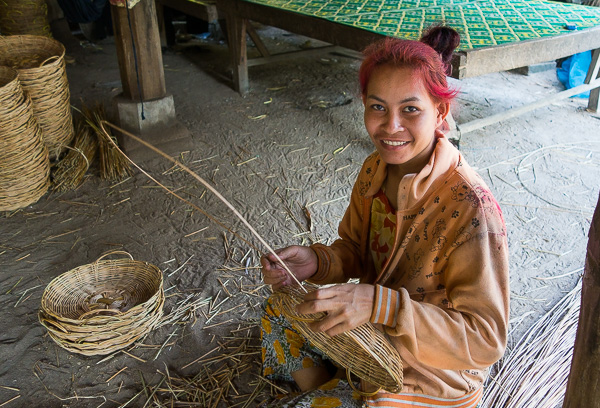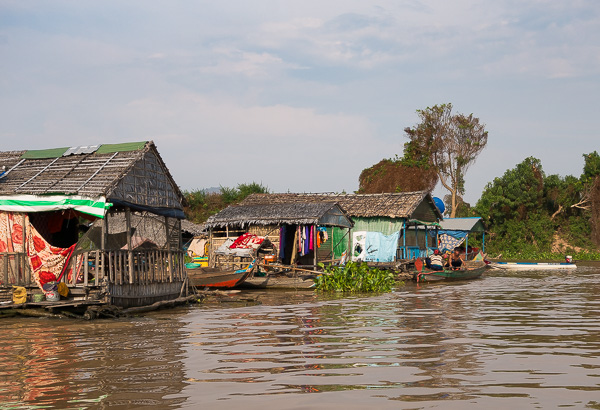In well-traveled parts of the world, getting off the tourist track is both an alluring proposition and an incredible challenge. Many places remain off of tour itineraries and out of guide books precisely because of the difficulties in either getting there, staying there, eating there, or finding something to do. However, there are those special places, few and far between, that allow travelers to see something absolutely authentic with relative ease. Welcome to Kampong Chhnang.
About Kampong Chhnang
Kampong Chhnang (the name of both the city and the surrounding province) is one of the central provinces of Cambodia, just off the southern point of Tonle Sap Lake and only 57 miles (but the world away) from the capital, Phnom Penh.
The name in Khmer translates to mean Port of Pottery, a nod to the time when the city was actually a coastal port town before sediment flowing down the Mekong River pushed the coastline further south. However, it retains its artisanal roots to this day in the form of small village communities that still produce most of the country’s pottery and bamboo goods.
Kampong Chhnang’s central location makes it easy and cheap to get to from just about anywhere. Simply ask your guesthouse to book your transport from an array of options (ranging from large buses to mini buses or even postal trucks) and you’ll likely arrive within a few hours and spend under $10.
Guesthouses and hotels are relatively plentiful and inexpensive, though simple. We stayed at the Garden Guesthouse. Expect to receive a warm welcome and a clean room upon arrival. Any more than that might be wishful thinking but after experiencing the surrounding area, you’ll realize you don’t need much more.
Things to do in Kampong Chhnang
The best way to explore, in our opinion, is by tuk-tuk (or moto kangbey in Khmer) as it will not only allow you to venture far beyond where you could get on a bicycle but also because most of the sites require some translation or explanation. Being able to actually converse with the artisans weaving bamboo or shaping the pottery enhances the experience far beyond the $20-30 fee for a full-day. While the tuk-tuk driver will likely lay out itinerary options worth pursuing, there are absolutely some places that are must-visits.

Slightly different than the tuk tuks in other parts of Southeast Asia, the moto kangbey was a great mode of transport around Kampong Chhnang.
Pottery Village
First, a trip to the Port of Pottery would not be complete without stopping by the pottery village a few kilometers outside of town. The best place to stop is called “Kampong Chhnang Pottery” in Google maps. The workshop is supported by a Japanese enterprise group that provides years of training in order to maintain traditional Khmer pottery-making techniques that would otherwise be lost. The ceramics are made out of local clay by local artisans and fired in traditional brick-oven kilns on-site. Best of all, the whole process is done out in the open for people visiting to watch. Finally, the quality and design of the goods coming out of this workshop are unparalleled in the region.

Pottery in process at “Kampong Chhnang Pottery.”
Bamboo Village
Another worthwhile sightseeing expedition is cruising through the bamboo weaving villages that surround Kampong Chhnang city. Each of these villages contains households that have been making baskets, spoons, and other assorted bamboo goods for generations – all by hand and using traditional methods. Watching the construction of these items is interesting enough on its own but the experience is infinitely enhanced when you’re invited into somebody’s home to watch it.

One of the homes that we visited in the Bamboo Village. Each home had a different specialty, here they were making small baskets that are used by Cambodians in their daily life.
Tonle Sap Floating Village
While the lifestyles of the previously mentioned villages contain many similarities, the floating villages in the Tonle Sap River are totally different and an absolute must-see. Weaving your way through the “neighborhood” on a traditional longboat exposes every aspect of life in the village. Watch as the local “grocery store” floats from boat to boat selling various greens and sauces or as a father teaches his son how to throw a fishing net.

A few of the hundreds of houses that make up the floating village near Kampong Chhnang in Tonle Sap Lake.
Kampong Leaeng
A side trip to the close-by Kampong Leaeng District, just a 20-minute ferry ride east of Kampong Chhnang, trades in watching the activities of the present-day culture for wondering about an ancient one. The district features a number of pre-Angkorian temples in beautiful, often remote, settings giving an even better perspective of local life in rural Cambodia. While they can’t match the grandeur of the better-known tourist center to the north, they are more peaceful and significantly less expensive (i.e. free) making them a must-do while in the vicinity.

One of the temples that we found in Kampong Leaeng. This one, in the middle of a field.
With the positives Kampong Chhnang has to offer, there are still a few challenges. As mentioned above, the lodging options tend to run more simple than spectacular. In addition, as tourism is NOT the primary industry, the dining options are also more limited though Sarah and I found a few places we enjoyed. There is a good list to choose from here.
Put simply, we loved our time in Kampong Chhnang and believe it provides travelers a better glimpse into the lives of average Cambodians than any of the major tourist hot spots. The people were incredibly warm and welcoming throughout our visit and the sights, scenery, and experiences we had there remained a highlight for the rest of our time in the country.

Our guide through the floating village. She lives in the village with her family and we got to visit her home and meet her parents and children.




Grant
March 30, 2018 at 8:06 pmThanks for the suggestions. We are here now and enjoying our time, but dining is definitely uninspiring. Regardless, we feel the same that this in one of those rare places where you get the true culture without it being structured and packaged into a paid tour. The nicest people we have met anywhere in the world as well.
thelawsoftravel@gmail.com
April 1, 2018 at 5:16 amYes, the dining leaves a lot to be desired, but the people made up for it. Enjoy!